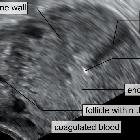gleichzeitige intrauterine und ektope Schwangerschaft








Heterotopic pregnancy is a rare situation when there is an intra-uterine and extra-uterine (i.e. ectopic) pregnancy occurring simultaneously.
Epidemiology
The estimated incidence in the general population is estimated at 1:30,000 (for a naturally conceived pregnancy ). The incidence among patients with assisted reproduction is higher and is thought to be around 1-3:100 . Due to this, the overall incidence has increased over the years.
Heterotopic pregnancies have been diagnosed from 5-34 weeks of gestation with up to 70% diagnosed between 5-8 weeks of gestation, 20% between 9-10 weeks, and only 10% after the 11week .
Pathology
Risk factors
Recognized risk factors predisposing to this condition include:
- assisted reproductive techniques: multiple embryo transfer and ovulation induction
- use of an intrauterine contraceptive device
- prior tubal surgery
- history of pelvic inflammatory disease
- history of a previous ectopic pregnancy
Radiographic features
Ultrasound
Classically shows features of an intra-uterine pregnancy as well as an ectopic pregnancy.
Treatment and prognosis
An ultrasound-guided ablation or laparoscopic removal of the extra-uterine fetus can be considered in patients who have a known heterotopic pregnancy to permit the intrauterine pregnancy to continue normally.
Medical management, although used successfully for an ectopic pregnancy, has a limited role in the management of heterotopic pregnancy as one must try to preserve and protect the intrauterine pregnancy.
Differential diagnosis
Considerations include:
- ectopic pregnancy with an intra-uterine pseudogestational sac
- intra-uterine gestation with a hemorrhagic corpus luteum
Siehe auch:


 Assoziationen und Differentialdiagnosen zu
Assoziationen und Differentialdiagnosen zu 